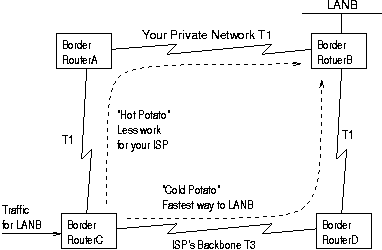Hot potato and cold potato routing
These
weeks I have been studying about networks, indeed about CCNP
certification, because my CCNP certificate expires soon, actually
next month, and I have to recertify.
I wrote about my experience in the CCNP
Route exam, CCNP
Switch exam and CCNP
Tshoot exam three years ago and I
though I wasn't going to learn something new this time
but I was wrong, I have learnt new concepts
like “Hot potato and cold potato routing” and
I have also reinforced my networking skills. The ID of exams has
changed with regard of the last time:
- 300-101 ROUTE → Implementing Cisco IP Routing (ROUTE v2.0)
- 300-115 SWITCH → Implementing Cisco IP Switched Networks (SWITCH 2.0)
- 300-135 TSHOOT → Troubleshooting and Maintaining Cisco IP Networks (TSHOOT v2.0)
Hot potato and cold potato is used when we speak about routing in
autonomous systems. In fact, hot potato is the normal behavior in a
routing environment when we don't have to configure any routing
engineering to the traffic. Therefore, routes are learnt and prefixes
are advertised without any particular configuration. To sum up, hot
potato routing is used to deliver traffic as quickly as possible from
one autonomous system to another without any traffic engineering.
However, hot potato routing has some disadvantages. For instance, if
we have a multihome network with two service providers (ISP1 and
ISP2) to access to Internet, we could come across with an asymmetric
routing issue. I mean, ISP1 would be used by uploading
traffic and ISP2 would be used by downloading traffic, which could be
an issue if we want to use one of the service provider, for example
ISP2, as a backup connection to Internet because this backup service
provider is more expensive, less reliable or we have less bandwidth
contracted. If we want to solve these issues, we have to use cold
potato routing.
Cold potato routing is more expensive than hot potato routing because
we have to configure traffic engineering to deliver traffic as we
want. Therefore, network administrators have more control over the
traffic with cold potato than hot potato, which means we can give
higher quality of service to our customers and it is better for
content providers as well. However, if we use this technique we have
to be willing to deliver our traffic for further distances because we
are going to choose suboptimal routing from the point of view of hops
but optimal routing from the point of view of performance, costs,
etc.
For example, if we want to solve the asymmetric routing issue in a
multihome network with a backup service provider we should look at
the next BGP path selection to choose some techniques to deliver
services as we want:
- Weight
- Local Preference
- Locally originated routes
- AS_PATH
- Origin
- MED (metric)
- eBGP routes over iBGP
- IGP metric to next hop (“Hot potato”)
- Vendor-dependent tie break
We'll see the results of my CCNP exam, but in the meantime I'm going
to keep studying new concepts like Windows Scaling (RFC 1323), Long
Fat Networks (LFNS), TCP selective acknowledgement (RFC 2018), EVN
Trunk, Unicast Reverse Path Forwarding (URPF), Tribal Flood Network
(TFN), etc.
Regards my
friend and remember, drop a line with the first thing you're
thinking.










Commentaires
Enregistrer un commentaire